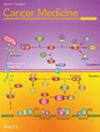Nomograms for predicting recurrence of HER2-positive breast cancer with different HR status based on ultrasound and clinicopathological characteristics
Abstract
Purpose
This study aimed to identify ultrasound and clinicopathological characteristics related to recurrence in HER2-positive (HER2+) breast cancer, and to develop nomograms for predicting recurrence.
Methods
In this dual-center study, we retrospectively enrolled 570 patients with HER2+ breast cancer. The ultrasound and clinicopathological characteristics of hormone receptor (HR)−/HER2+ patients and HR+/HER2+ patients were analyzed separately according to HR status. Eighty percent of the original samples from HR−/HER2+ and HR+/HER2+ patients were extracted by bootstrap sampling as the training cohorts, while the remaining 20% were used as the external validation cohorts. Informative characteristics were screened through univariate and multivariable Cox regression in the training cohorts and used to develop nomograms for predicting recurrence. The predictive accuracy was calculated using Harrell's C-index and calibration curves.
Results
Three informative characteristics (axillary nodal status, calcification, and Adler degree) were identified in HR−/HER2+ patients, and another three (histological grade, axillary nodal status, and echogenic halo) in HR+/HER2+ patients. Based on these, two separate nomograms were constructed to assess recurrence risk. In the training cohorts, the C-index was 0.740 (95% CI: 0.667–0.811) for HR−/HER2+ nomogram, and 0.749 (95% CI: 0.679–0.820) for HR+/HER2+ nomogram. In the validation cohorts, the C-index was 0.708 (95% CI: 0.540–0.877) for HR−/HER2+ group, and 0.705 (95% CI: 0.557–0.853) for HR+/HER2+ group. The calibration curves also indicated the excellent accuracy of the nomograms.
Conclusions
Ultrasound performance of HER2+ breast cancers with different HR status was significantly different. Nomograms integrating ultrasound and clinicopathological characteristics exhibited favorable performance and have the potential to serve as a reliable method for predicting recurrence in heterogeneous breast cancer.


 求助内容:
求助内容: 应助结果提醒方式:
应助结果提醒方式:


